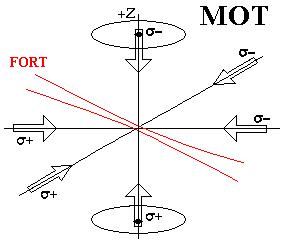Cold Atom Photoassociation, Cold Molecule Production, and Ultracold Atomic Collisions
Our group pioneered the development of cold atom photoassociation spectroscopy in 1993, and has been carrying out leading work in this field since that time. In this process, atoms that have been laser-cooled to micro-Kelvin temperatures collide in the presence of a laser field. During the collision, the initially free pair of atoms is optically excited to a bound molecular state. Because the free-state thermal energy spread is negligibly small, this process leads to a well resolved free-bound absorption spectrum. This "photoassociation spectroscopy" is proving to be a powerful tool for the analysis of atomic interactions at long range. In turn, knowledge of these interactions is crucial for the development of cold atomic clocks, Bose-Einstein condensation, and other applications of laser-cooled atoms. Finally, photoassociation is an excellent probe of ultracold collisions, allowing us to study cold collision physics in unprecedented detail.

Our photoassociation apparatus is shown above. At the heart of the apparatus is a two-stage optical atom trap. The first stage, a so-called "cell MOT," captures about 105 atoms from a dilute background gas of Rb atoms and laser cools them to temperatures of 200-300 microKelvin. About 104 of these atoms are transferred into a far-off resonance trap (FORT), which consists of a single focused laser beam tuned far to the red of the first atomic resonance transition. The FORT allows us to trap atoms at a very high density (good for the collision rate!). Another laser is superimposed on the atoms, and we observe the photoassociation spectrum as this laser is tuned.
We have obtained many new results from this apparatus, including:
- The first observation of a well-resolved, assignable cold atom photoassociation spectrum.
- The first observation of a "pure long range" molecule.
- The first observation of shape resonances in ultracold atomic collisions.
- The first detailed study of spin-polarized ultracold atomic collisions, in which the contributions of individual partial waves were resolved!
- The first direct observation of time dependence in ultracold atomic collisions.
- The first measurement of the scattering lengths for collisions of ground state Rb atoms, which are the crucial parameters in the description of a Rb Bose-Einstein condensate.
- The observation of an assignable ground state spectrum of the last bound states of Rb2 with two-color photoassociation spectroscopy.
- An observation of a Feshbach resonance in collisions of laser-cooled 85Rb atoms, which would allow for tuning of the scattering length of an 85Rb BEC.
- A measurement of the atomic lifetime of the Rb 5P state which is accurate to about 0.3 %.
These results are described in several of our publications.
An important aspect of our work is a close collaboration with Boudewijn Verhaar's group at the Eindhoven University of Technology. Boudewijn is one of the leading theorists in the area of ultracold atomic collisions. Because of this collaboration, we are able to maintain a very close contact between theory and experiment, and to accomplish more than we could working in isolation. For instance, we have rapid access to sophisticated fully quantum computer modelling of our results.
We also have active collaborations with Alex Dalgarno of Harvard, and Paul Julienne of the National Institute for Standards and Technology on complementary aspects of our work.
Our present efforts in this project are focussed in two areas: First, we plan to carry out a more complete and precise measurement of the Rb2 photoassociation spectrum. One thing we would like to understand better is the spectrum of the Rb2 0u+ states which dissociate to the 5S + 5P limit. It turns out that these states are not well approximated as vibrational eigenstates of adiabatic Born-Oppenheimer potentials: nonadiabatic couplings are important to all 0u+ levels and must be considered in the zero-order description of the molecule. We would also like to improve the accuracy of our spectra so that we can determine a more precise atomic lifetime, and observe relativistic and retardation effects in the atomic interactions. A second important project is that we are preparing to try to trap, detect, and study ultracold ground state molecules formed by cold atom photoassociation.

